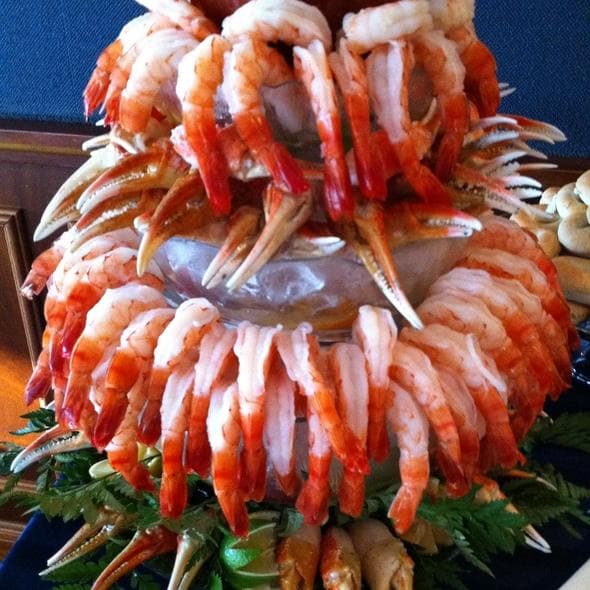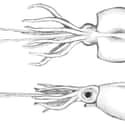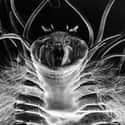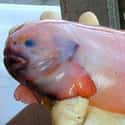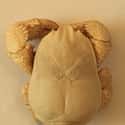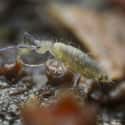-
(#5) Colossal Squid
The creature thought to have inspired the mythical Kraken has rightfully earned a spot on any creepy animal list. It was long thought to be legendary, since the colossal squid is extremely elusive and tends to live at relatively deep depths around Antarctica. In fact, it wasn't discovered to be real until 1925, when giant tentacles were found in the belly of a whale. In 2003, an almost-intact squid was found, and humanity had to wait until 2007 for someone to capture one on video.
One thing that differentiates a colossal squid from a giant squid (aside from the size) is the presence of swiveling hooks inside the suckers on a colossal squid's tentacles. These hooks are apparently pretty nasty too, as many sperm whales have been found with horrible scars, presumably dealt to them by a colossal squid. If the terrifying hooks aren't enough to creep you out, a colossal squid also has the biggest eyes of any creature on Earth.
-
(#2) Ice Worm
Ice worms are related to leeches and earthworms, and these creepy crawlers are well adapted to life in the cold. They are able to regulate their body temperature so their insides don't freeze. They burrow deep into the surfaces of glaciers and tend to hide there during the day, since they run the risk of dying in warmer temperatures.
If you've ever tried walking on ice, you know it's quite easy to slip. Ice worms, however, transport themselves across and through glaciers by using small bristles on the outside of their bodies to grip the ice and give themselves some traction. And they're pretty good at it too, traveling up to 10 feet per hour across icy surfaces.
-
(#4) Snailfish
Snailfish are named for their loose, gelatinous skin that takes the place of scales. At the bottom of their tadpole-shaped bodies are giant suckers, which they use to attach themselves to rocks or other objects on the ocean floor. There are about 335 species worldwide, 20 of which make their home in Arctic waters.
They may be somewhat comical, but they have a unique ability: they can live in the deepest parts of the sea, including the Mariana Trench.
-
(#10) Hairy Chested Hoff Crab
This crab really is named after David Hasselhoff due to its hairy appearance. This strange hybrid-looking creature was found at a depth of 2,000 meters in Antarctic waters, a spot that is extremely cold.
Hoff crabs survive the low temperatures by hanging out around hydrothermal vents, like campers crowding around the fire to keep warm. But they have to be careful: too close and they'll boil themselves; too far away and they'll freeze. As a bonus, the vents are ideal breeding grounds for the bacteria the crabs eat.
-
(#6) Tardigrade
- Tardigrada
Tardigrades are one of the most unusual organisms found in Antarctica. They are also known as "water bears" for their plump bodies and clawed limbs, and are thought to be one of the tiniest creatures found on Earth. But anything that can survive in Antarctica shouldn't be judged by its size. In addition to being one of the smallest animals on the planet, they are also one of the oldest.
Tardigrades have the unique ability to remove all water from their bodies and replace it with a sugar, kind of like freeze-drying themselves in order to survive in harsh environments. They were even launched into space to test their tenacity. Most passed the test by surviving cosmic rays, normally deadly levels of UV radiation, and the vacuum of space with flying colors.
-
(#11) Springtail
- Collembola
Since seals and penguins are only visitors to, and not residents of, Antarctica, the continent's largest creature award goes to an arthropod. There are indeed insect-like organisms in Antarctica, proving there really is nowhere safe from creepy, crawly creatures. Springtails live under rocks along the coast of the continent, and like many other creatures that live in extreme environments, have specially adapted to live in the cold.
Although it is possible for them to freeze to death, springtails use glycerol to keep their bodies safe from temperatures that are too cold. They also have the special ability to slow down their metabolisms to save their bodies from using too much energy, and can go into a hibernation-like state when conditions get too extreme.
The name "springtail" comes from a tail-like protrusion under their abdomen which they use to jump great distances. This unique ability has also given them the nickname "snow fleas."
New Random Displays Display All By Ranking
About This Tool
In the extremely cold polar regions of the world, a variety of creatures thrive there with tenacious perseverance. There are the Arctic terns that travel to and from the poles of the earth, the emperor penguins, the beluga whales, and the polar bears that dominate the snow world, and more. These unique animals make the cold areas full of vitality.
Several birds and mammals have experienced long migrations and thrived in the polar regions and survived for generations, they have fully adapted to the harsh polar climate. Here the random tool lists 15 crazy animals in the polar regions that can not be found in any other region.
Our data comes from Ranker, If you want to participate in the ranking of items displayed on this page, please click here.

